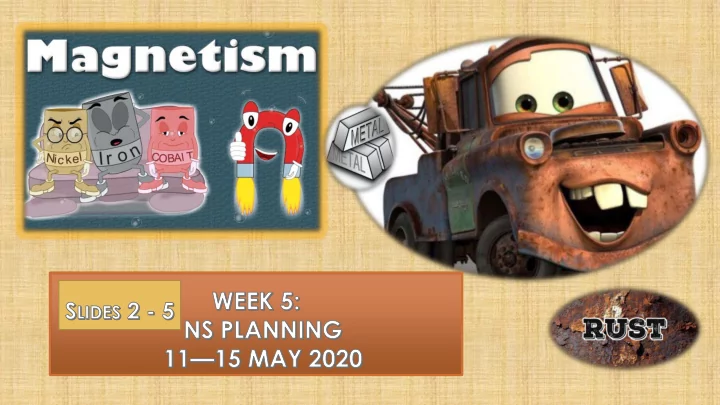

SLIDE 2: ACTIVITY 1: USES OF METALS: MAGNETISM You have learnt over the past two weeks that metals have special properties. Revise these properties from week 4 slide 2. Here is one to add to your properties list. Some metals are MAGNETIC . Watch the Video link : https://www.youtube.com/watch?v=aNpmCSZHbk Magnets and Magnetism | Magnets Video for Kids Let’s see how well you listened to the video clip : Answer with a word / words only. 1. What did the narrator use to attract the iron nails? Iron , Nickel and 2. What is the force of magnets called? Cobalt are 3. What are the name of the three types of magnets? magnetic metals. 4. Does a magnet have to be (a) very close to an object to be able to pull it / (b) can it pull it from a distance? Steel contains 5. What two poles does any magnet possess? iron so it is 6. What field is created around the magnet? magnetic. 7. We say that two LIKE POLES like a South and a South or a North and North Pole _______________________ each other, but the OPPOSITE / UNLIKE poles (North and South) _________________________________ each other. Acronym to 8. Not all objects are magnetic. Name ANY four different materials that are non-magnetic. remember the magnetic metals: 9. CERTAIN METALS are magnetic because they are rich in iron, _________________________ and in _______________________________. INC (S ) 10.Why do you think that the earth is able to be a massive magnet? (See your previous answer to guide you.) 11.Where in our every day life are magnets used? (Giveany 3 examples.) Copy note under IRON NICKEL answers to quiz. COBALT (STEEL )
Watch the video on rusting. 1 https://www.youtube.com/watch?v=qd2B9yCKzc0 Rusting of Iron |# ausum#kids#science COPY NOTE ON A NEW PAGE WITH SLIDE HEADING. 2 All metals e.g. gold, silver, brass, copper, iron, steel, zinc, cobalt, aliminium etc. start off as shiny, but they will get dull if not polished. Metals will either tarnish (become dull) or they will corrode (rust). 1. Rust has a reddish-brown colour and a rough texture. Rust is very common and forms when iron /or iron and steel corrodes. ❑ During corrosion, iron reacts with oxygen in the air and with water vapour to form ❑ iron oxide. Rust is a type of corrosion, but there are other types which include: 2. Tarnish, found on silver teapots, trays, trophies and jewellery. 3. Patina, the green coating that we sometimes see on copper objects. 4. Black spots that appear on brass. 3 . ONLY OBJECTS (Remember and learn it as this Acronym: ) 4
Watch the interesting, fun experiment on how rust forms. You DO NOT need to learn any equations. https://www.youtube.com/watch?v=LQ-prcAHM_U Primose Kitten: Tutorials for Chemistry and Physics: (Rusting - Iron + water + oxygen = iron oxide) You can try doing the same experiment at home for fun with a parent or your older brother / sister if you have time. Copy Note on a new page with slide heading: ❑ Metals that contain Iron / Steel with Iron will RUST. ❑ To prevent Iron and steel from rusting, we can Fig 1. Coat them with paint e.g. a car/bicycle Fig 2. Coat them with plastic Fig 3. Galvinise /paint them – e.g. fence/gate/metal furniture that stand outside Fig 4. Coat them with another metal that does not rust. Fig 5. Coat them with oil / grease.
Let us see how much you know? No sentences are required – answers only. Match the terms with the correct meaning e.g. 1(b) A B 1. 1.tarnish a. dull layers that appear on objects 2. rust b. when a metal is attracted to a magnet 3. magnetic c. paint with special paint to treat a metal against rust 4. galvinise /paint d. reddish-brown layer that appears on iron Use week 5 slides 2-4 to assist you . 2. Name three metals that are magnetic. (slide 2) 3. Why does iron become dull and rust when it stands outside for a long time. (slides 3 and 4) 4. What is another name for rust? (see slide 3) 5. Your dad has put up an iron fence. What advice would you give him about treating it? (slide 4) 6. Many people put Aliminium windows in their homes instead of steel frame windows. Why do you think steel frame windows are not the best choice? Think of what our window frames look like in class. (slide 3) Use week 4 slides 2 and 3 to assist you. 7. Brass’s best property is that it is strong, hard and heavy so it is used to make door handles. Would you make a teaspoon from brass? Why not? 8. Why do we use metal cutlery like knives, forks and spoons and not plastic in our homes. 9. Why is the head of a hammer made from a metal and not a non-metal? 10. Which property is important to enable pots to cook our food?
Recommend
More recommend